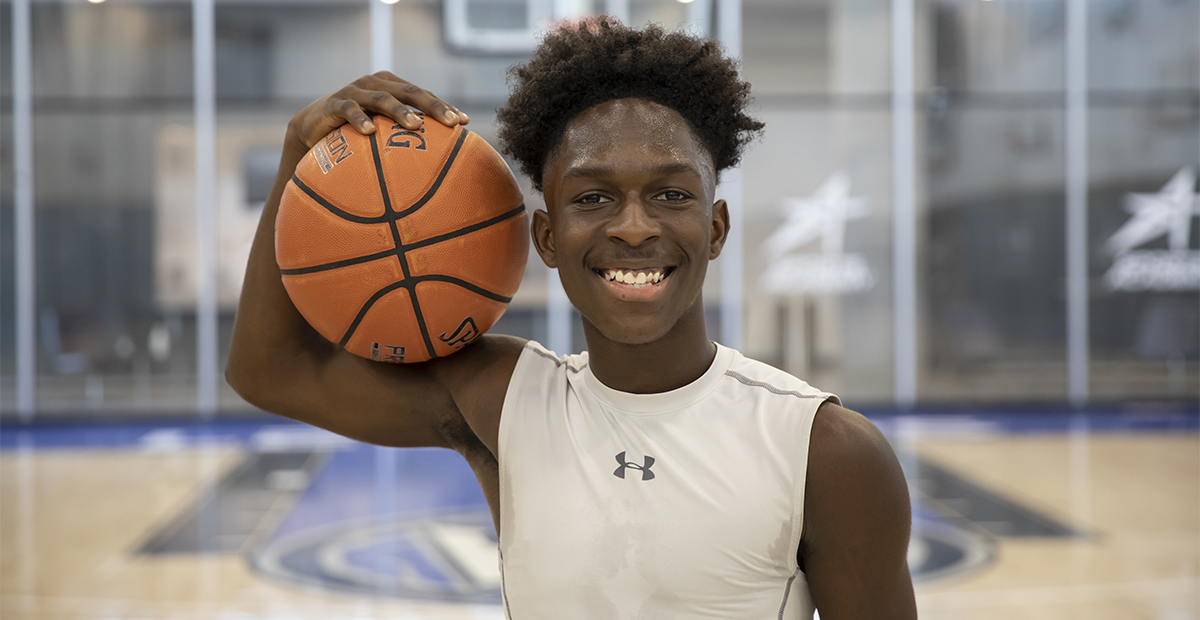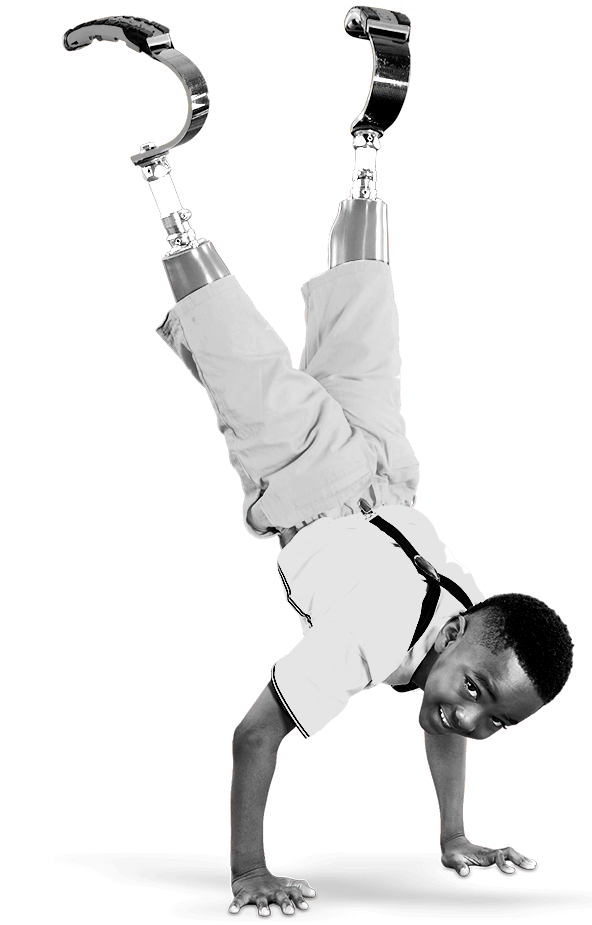
Dec 03, 2021 / Sports Medicine
Game Changer: Concussion Experts with the Assist
Article previously published in Rite Up, 2021 – Issue 3.
Watching the basketball ricochet off the rim, Solomon zeroed in on the ball and crowded up next to his opponent. He was guarding closely to block the player’s next shot. “I tried to take a charge from him,” 13-year-old Solomon says. “I fell back, and I don’t remember what happened after that. I just woke up in the hospital.”
Solomon toppled onto his back, and that driving force slammed the back of his head against the gym floor. This serious fall halted the semi-final game and silenced the crowd. In that blank space in Solomon’s memory, he lost consciousness several times while bearing down from the pain. When the ambulance arrived, he was put on a stretcher, his jersey cut off and paramedics applied a neck brace for the ambulance ride.
Out of state at a tournament, Solomon was released from care and cleared to fly home to Texas. Carl and Leah, his parents, knew something was wrong from his behavior, and Solomon told them he had a horrible headache and nausea. They quickly made an appointment with the sports medicine experts at Scottish Rite for Children in Frisco.
Sports medicine physician and sport-related concussion specialist Shane M. Miller, M.D., assessed Solomon and confirmed a sport-related concussion. “Concussion management is a team approach, but the care is individualized to the needs of each athlete,” Miller says. “Unfortunately, injuries occur during sports, but how you respond is critical. Early recognition and treatment, with a supportive family and coaches leads to better outcomes and a quicker return to play.”
Miller and the sports medicine team directed Solomon and his family about next steps. “Early on, it is important to protect the athlete from further injury, so they take a break from their sports activity. Solomon was playing basketball at a very high national level, but his family understood the importance of properly treating his injury and ensuring a full recovery, which is so important for a young athlete.”
Miller says adjustments are made to the school environment to allow for continued learning during recovery, and as symptoms improve, physical activity is gradually increased until the athlete has fully recovered and receives clearance to return to play. This process is usually a few days to weeks, and most young athletes will fully recover from a concussion within a month.
“It was awesome knowing he was taken care of from the moment he walked in the door,” Leah says. “We saw very professional and very informative doctors who could explain the concussion treatment in a way that Solomon could understand. Everybody was supportive, not only of Solomon, but also of us as well, to make sure he gets better the way he needs to.”
Solomon was eager to work within the recommended guidelines to get back to the sport he loves. He also participated in one of Scottish Rite’s ongoing studies looking at changes in gait, balance and cognitive activities following a concussion. “Our highly specialized team and state-of-the-art equipment in the Movement Science Lab allow us to conduct research that many other facilities don’t have the ability to perform,” Miller says. “This contributes to the data that changes how we manage injuries and hopefully helps Solomon and other young athletes recover from their injury and return to their sport faster and safer.”
“The movement science program was very cool,” Carl says. “They were able to track Solomon’s movements from a vestibular standpoint, measuring his balance and stability. They put all these markers on him, and he looked like they were making a video game with him.”
Cleared for the court, Solomon is fully back in action. “I really need to read the court and know who to pass to — there’s really a lot of thinking I do,” Solomon says. “Without Dr. Miller, I wouldn’t be able to do this stuff because I’d still be dizzy and having headaches in the game. But now I’m 100%, and I can really focus on what I’m trying to do.”
Read the full issue.
Watching the basketball ricochet off the rim, Solomon zeroed in on the ball and crowded up next to his opponent. He was guarding closely to block the player’s next shot. “I tried to take a charge from him,” 13-year-old Solomon says. “I fell back, and I don’t remember what happened after that. I just woke up in the hospital.”
Solomon toppled onto his back, and that driving force slammed the back of his head against the gym floor. This serious fall halted the semi-final game and silenced the crowd. In that blank space in Solomon’s memory, he lost consciousness several times while bearing down from the pain. When the ambulance arrived, he was put on a stretcher, his jersey cut off and paramedics applied a neck brace for the ambulance ride.
Out of state at a tournament, Solomon was released from care and cleared to fly home to Texas. Carl and Leah, his parents, knew something was wrong from his behavior, and Solomon told them he had a horrible headache and nausea. They quickly made an appointment with the sports medicine experts at Scottish Rite for Children in Frisco.
Sports medicine physician and sport-related concussion specialist Shane M. Miller, M.D., assessed Solomon and confirmed a sport-related concussion. “Concussion management is a team approach, but the care is individualized to the needs of each athlete,” Miller says. “Unfortunately, injuries occur during sports, but how you respond is critical. Early recognition and treatment, with a supportive family and coaches leads to better outcomes and a quicker return to play.”
Miller and the sports medicine team directed Solomon and his family about next steps. “Early on, it is important to protect the athlete from further injury, so they take a break from their sports activity. Solomon was playing basketball at a very high national level, but his family understood the importance of properly treating his injury and ensuring a full recovery, which is so important for a young athlete.”
Miller says adjustments are made to the school environment to allow for continued learning during recovery, and as symptoms improve, physical activity is gradually increased until the athlete has fully recovered and receives clearance to return to play. This process is usually a few days to weeks, and most young athletes will fully recover from a concussion within a month.
“It was awesome knowing he was taken care of from the moment he walked in the door,” Leah says. “We saw very professional and very informative doctors who could explain the concussion treatment in a way that Solomon could understand. Everybody was supportive, not only of Solomon, but also of us as well, to make sure he gets better the way he needs to.”
Solomon was eager to work within the recommended guidelines to get back to the sport he loves. He also participated in one of Scottish Rite’s ongoing studies looking at changes in gait, balance and cognitive activities following a concussion. “Our highly specialized team and state-of-the-art equipment in the Movement Science Lab allow us to conduct research that many other facilities don’t have the ability to perform,” Miller says. “This contributes to the data that changes how we manage injuries and hopefully helps Solomon and other young athletes recover from their injury and return to their sport faster and safer.”
“The movement science program was very cool,” Carl says. “They were able to track Solomon’s movements from a vestibular standpoint, measuring his balance and stability. They put all these markers on him, and he looked like they were making a video game with him.”
Cleared for the court, Solomon is fully back in action. “I really need to read the court and know who to pass to — there’s really a lot of thinking I do,” Solomon says. “Without Dr. Miller, I wouldn’t be able to do this stuff because I’d still be dizzy and having headaches in the game. But now I’m 100%, and I can really focus on what I’m trying to do.”
Read the full issue.



